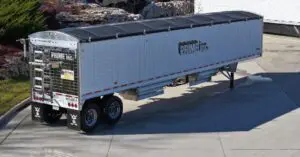Slick conditions, heavy winds and wet weather are dangerous for anyone on the road. Bad weather conditions are especially hazardous for those hauling loaded tractor-trailers weighing up to 80,000 pounds.
In 2018, the Federal Motor Carrier Safety Administration (FMCSA) reported that 4,862 large trucks were involved in fatal crashes, while 59,933 were involved in injury-related crashes. Additionally, 111,291 large trucks were engaged in towaway crashes that year.
While accidents can happen at any time, severe weather increases the risk of a wreck. FMCSA found that 23 percent of large truck crashes related to speeding happen when weather conditions are less than ideal.
Commercial drivers must pay close attention to their driving behavior as well as the actions of drivers nearby. Braking, following distances and stopping distances are all affected by wet roads.
In parts of the country, summer brings heavy rains, tornadoes and severe thunderstorms. Read more for summer storm safety tips to prepare yourself for bad weather while out on the road.
Before You Leave: Watch the Radar & Limit Distractions
The only way to avoid severe weather is to know when it’s coming. Before you head out, check the forecast in your area and along your route. Services like The Weather Channel let you enter cities and zip codes to see live radar and hourly predictions. If you think your planned path will lead you into a storm, look for ways to re-route so you won’t get caught in the middle of it.
It’s helpful to take note of the counties you’ll be driving through, too. On the radio, weather services will call out warnings by county.
Distracted driving is dangerous on clear, sunny days. Combine it with bad weather, and you have a recipe for disaster. Drivers should limit distractions if they’re moving into bad weather.
- Don’t use your phone.
- Turn down music.
- Stay off CB radio.
- Focus on the road.

What You Need to Know About Driving in Bad Weather Conditions
Always drive with caution if storm clouds are drawing near. Below are some types of weather you may experience this summer, whether you’re driving regionally or across the country.
Tips for Driving in Thunderstorms
Severe thunderstorms occur more often in some parts of the country, like the South. Thunderstorms are also common in the Midwest, from Texas up to southern Minnesota. Sometimes thunderstorms only cause heavy rain and lightning. However, they can also produce large hail and tornadoes.
The National Weather Service classifies severe weather with watches and warnings. These categories are based on how likely storms are to appear or if they are currently in progress. Do you know the difference between a severe weather watch and a warning? You can use these notifications to determine how close the storm is and if you should consider a different route.
- A severe thunderstorm watch means a thunderstorm may develop in the area. Watches stay in effect for hours.
- Once a storm meets specific criteria, it moves from a watch to a severe thunderstorm warning. These storms are expected to produce or are currently producing large hail at least one inch in diameter and high-speed winds stronger than 58 miles per hour.
Along with severe storm warnings, you will also encounter flash flood and tornado warnings.
- A flash flood watch means there’s a possibility of flooding in the area.
- Flash flood warnings refer to rapid flooding of rivers, streams and low-lying land. In certain places, flash flooding can cover and block roads.
- Tornado watches indicate that the current weather conditions are favorable for a tornado. Like other weather watches, tornado watches can be in effect for hours as a storm develops.
- A tornado warning means a tornado has been spotted in person or sighted on radar. Under a tornado warning, people should find shelter and take cover.
Driving in Heavy Rain
At some point, you will encounter heavy rain. Wet weather driving makes it harder for you to control the truck. Heavy rain affects your visibility and traction, and there’s a risk of hydroplaning or jack-knifing your trailer during downpours.
- Reduce speed. When there’s 1 ½” of water on the road, tires must displace a gallon of water per second to maintain contact. The best rule of thumb for driving in heavy rain is to slow down and adjust your speed for the conditions. You should go even slower around curves and in heavy traffic.
- Change speeds gradually. Sudden acceleration or braking could cause you to lose control of the truck. During heavy rain, every action you take should be slow and gradual.
- Don’t use cruise control or the Jake brake. In adverse weather, drivers shouldn’t use cruise control or the engine break. These features can keep you from noticing if you’ve lost control of the truck.
- Increase stopping distance. In dry conditions, a fully loaded tractor-trailer moving at 65 miles per hour needs 525 feet to stop—almost the length of two football fields. When you add slick, wet roads to the mix, drivers need even more time to come to a stop and avoid hydroplaning.
- Increase following distance. A typical following distance is around seven seconds, giving drivers time to slow down if a vehicle in front of them decelerates or slams on the brakes. In rainy weather, drivers should increase their following distance. Less traction on the roads makes it harder to stop or enter new lanes quickly without losing control.
Dealing With Hail
Strong thunderstorms often call for hail. All sizes of hail can damage the body of your truck and make it hard to see. Driving down the interstate or highway can make visibility even worse as hail and rain pound your windshield. If hail is making it difficult to navigate, pull off the highway onto the shoulder or into a truck stop. If you can, angle your windshield away from the hail to avoid damage.
What About Lightning?
Lightning may be beautiful in the sky, but you want it as far away from you as possible. Depending on where you are, your truck may be the tallest metal object in sight, making it a potential target for a lightning strike. If you’re outside during a storm with lightning, remember to stay away from fuel pumps.
How to Drive in High Winds
Driving in high winds is dangerous for a big rig. Strong winds can easily pull and overturn high-profile vehicles. Drivers hauling empty or lighter loads are at a greater risk of being caught by the wind than those traveling with full, heavy loads.
- Secure your load. Wind can cause unsecured doors to open or freight to fall off the trailer—two things you don’t want to happen as you roll down the interstate. Before you leave, double-check your truck and trailer to make sure everything is secure.
- Pay attention. Winds can pick up easily. Watch the trees and foliage beside the road, as well as road signs, for movement.
- Keep your hands on the wheel. A windy day means you need to keep a firm grip on the wheel. The truck will try to move in whatever direction the wind is blowing. You need to be ready to hold the truck steady.
- Reduce speed. The faster you drive, the more the wind is going to pull you. Make it easier to maintain control by slowing down.
- Stay in the right lane. Wind can cause your trailer to move around, and it could knock into another vehicle. If you can, drive on the far right lane close to the shoulder to give you more space in case the trailer moves around.
Tornado Safety Tips While Driving
Tornadoes are most common in the central United States. The area east of the Rocky Mountains is known as Tornado Alley. Oklahoma and Texas experience the most tornadoes each year per 10,000 square miles.
Drivers should never try to “outrun” a tornado after a tornado warning has been issued. Tornados travel erratically and can change directions in an instant. If there’s a tornado in the area, drivers should get off the road and seek shelter indoors immediately.
If you can’t seek shelter indoors, your best case scenario is to leave your truck and find a ditch, culvert or ravine away from other vehicles. You want to find the lowest point of ground you can. Once there, lay low with your hands protecting your head.
During a tornado, do not try to seek shelter under a bridge or overpass. These areas cause winds to speed up, creating powerful funnel winds.
If you must stay in your truck, leave your seat belt on and keep the truck running. The airbags will remain on as long as your truck is on. Get down as low as you can in the seat and cover your head with a coat or blanket.
You Are the Captain of the Ship
Sometimes stopping is the safest thing to do in severe weather. At Prime Inc., we maintain a “captain of the ship” policy, which means you make the call. If you don’t feel comfortable with the driving conditions, you can pull over on the shoulder or park at a truck stop. No load is worth the life of the driver.
When you meet storms this season, the easiest way to reduce your risk of an accident is to adjust your speed and pay attention.
Start Your Career at Prime Inc.
Are you ready to make your career your own?
Prime Inc. offers competitive pay and benefits, along with training for new and experienced drivers. If you’re ready for adventure or tired of your nine-to-five job, trucking lets you support yourself while experiencing the freedom of the road.
Apply to Prime today using our online application. Need assistance? Contact our Recruiting Department at 866-290-1568 to learn more about becoming a truck driver.


